
About this time last year I helped my mother-in-law’s Kimjang at her house and in return, I brought home couple containers of her yummy Kimjang. This year, I decided that it was time I tried it all on my own. I was a bit worried that I may not be able to handle the large amount of ingredients but hey, you have to take risks in life, right?
In late September, after my potato harvest, we planted Korean cabbages (배추 Baechoo), radishes (무우 Moo), Korean leeks (대파 Daepa) and mustard greens(갓 kaat) at our family farm for Kimjang.
After about 2 months, they were ready for picking. These pictures were taken around 11/20 or so. I came home with 16 cabbages, 9 radishes and a huge bunch of mustard greens. Also about two large bunches of Korean leeks. I bought the rest from the market.
Because I basically used the same Kimjang kimchi recipe from last year I will not list it again here. However, I will write more in depth about prep work- especially brining/salting cabbages. I know I mentioned in my last year’s post how most people just buy already brined cabbages (절임 배추 jeorim baechoo) because people say that’s the most difficult part of Kimjang both in terms of complexity and effort. You can use these tips for pickling cabbages in making regular small batch Kimchi at home.
How to brine (pickle) Korean napa cabbage (배추 baechoo) for Kimchi:
Ingredients
- 5 KOREAN NAPA CABBAGES (about 6 lb/2.7 kg each)
- 12 Cups or 5 lb/2.3 kg coarse SEA SALT (bitterns removed)
- 70 Cups/16.5 litre/17.5 qt cold or lukewarm WATER
- 1 gallon size bowl
- 1 giant container or bathtub to hold cabbages while they are brined
- 1 giant strainer/colander to drain brined cabbages
Directions
- Clean cabbage – Clean and cut away any outer leaves that are too damaged, brown or dirty. Most likely, your local market will sell already cleaned cabbages in which case need to do nothing. **Make sure you leave some good greenish outer leaves so you can use it to wrap the kimchi at the end.
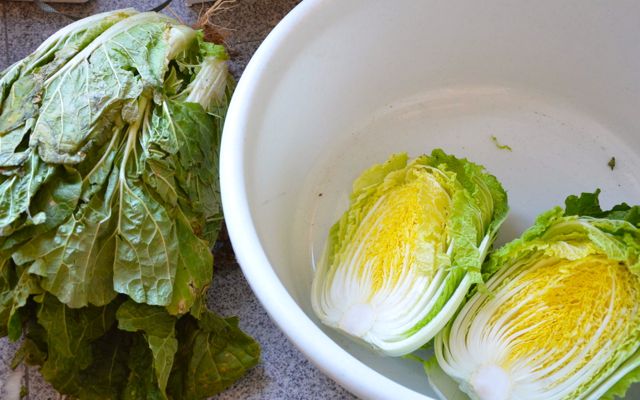
Cleaning cabbage for Kimjang kimchi Note how large the baechoo is on the left compared to the cleaned and cut ones on the right.
- Cut each cabbage in half. Tip for cutting cabbage for Kimchi: just cut about 1/3 of the bottom half (from the root end) and rip apart by hand. Like so –
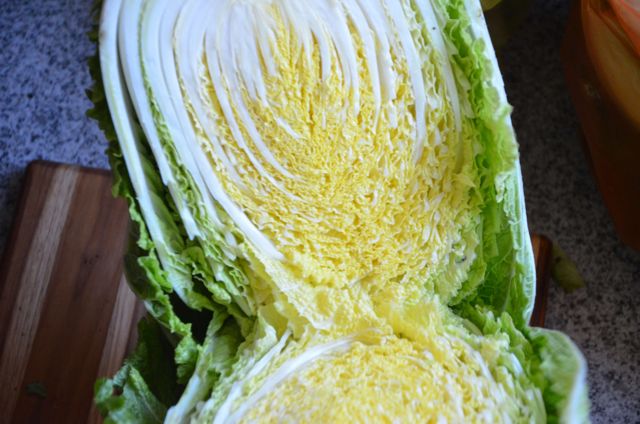
How to cut Kimjang cabbage baechoo in half It won’t be a huge disaster if you cut it all the way with a knife but it’s just easier this way and also you will not end up wasting cabbage pieces.
- In a large container, dissolve about 8 cups of salt and 17 1/2 quarts/70 Cups of cold or lukewarm water for the brine. Reserve remaining 4 cups salt for sprinkling. Please read my Kimjang tips post on discussion about salt. Solar sea salt is best if you can get them.
- Put cabbages in brine (made in step 3) – make sure the brine seeps fully into the cabbage by spreading out the leaves with your hands and swirling it around.
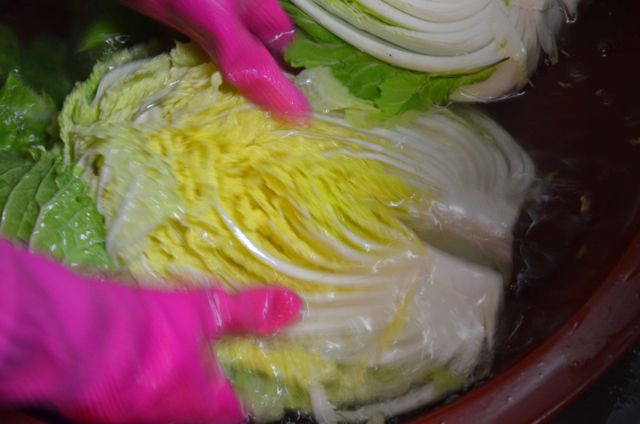
soaking cabbage in brine for Kimchi - Leave cabbages in brine for 2~3 hrs until the leaves start to get soft.
- When leaves are soft, For each 1/2 cabbage, REPEAT the following 3 steps:
-
- Take each cabbage out and let it drain for couple seconds and put in a bowl. DO NOT discard the brine because you will be putting cabbages back later on.
- Get a handful of salt from the remaining 4 cups and sprinkle (more like spraying) the salt in between leaves of each 1/2 cabbage, starting from the outer leaves. Aiming the salt mostly on the thick, white fleshy part of the cabbage.
- Put salted cabbages back into the brine.
-
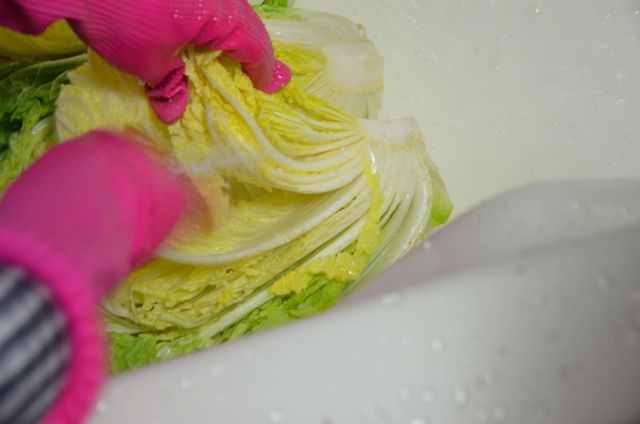
Salting cabbage for Kimchi ** We do this because the thick white fleshy part takes longer and more salt to pickle. You only need about 1/2 cup or less for each 1/2 cabbage. You may not need to do this if your cabbage has very thin white flesh or if you want to make your kimchi less salty.
7. Let cabbages sit in brine for another 10~12 hrs. Making sure cabbages are evenly pickled by rotating the ones on the top with the ones in the bottom, every 4 hrs or so.
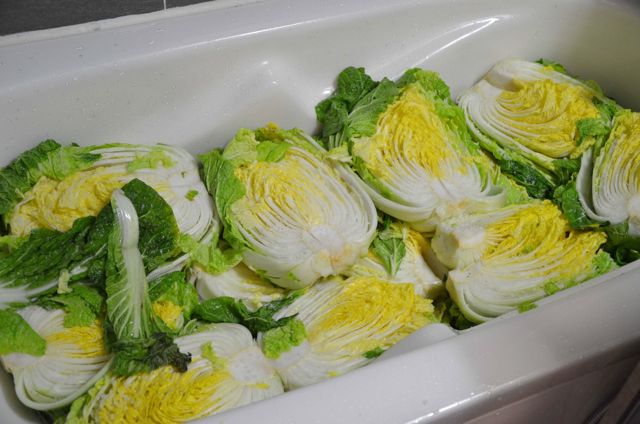
8. Next morning, the white part of the cabbage should be fully bendable like so-

9. Rinse cabbages 3 times thoroughly. Let cabbages drain for 1 hr or so. Place the cut side down when draining.
Now you are ready to make the seasoning and finish up the Kimchi!
For the list of ingredients and recipe – see my post Kimjang Day: Part 1 – How it’s done.
For more info on ingredients and other tips – see my post Kimjang Day: Part 2 – Ingredients and Tips
Some Kimchi recipes tell you to brine cabbages for 6-8 hrs (at room temp) and this can work well for smaller batches (in fact, that’s what I do in my Easy Blender Kimchi) but traditionally, Kimjang cabbages were pickled overnight in cold winter weather.
In my opinion, brining overnight works better simply in terms of scheduling because you can start brining cabbages at night time and then finish making Kimjang kimchi the next morning. If you brine them for only 6-8 hrs, then you either end up making Kimchi at wee hours of the night or you end up starting the pickling process after midnight. None of which is fun..
So in my case, I washed and cleaned all the vegetables first during the day and then started pickling the baechoo (cabbage) in our bathtub around 7pm. Which meant I could rinse it around 8 am next morning.
Well, now you have it! With my tips on how to pickle/brine Korean cabbages for Kimchi, you should be able to make a very delicious Kimchi anytime!
About the BRINE:
- Pickling in 15% salt solution is the traditional standard for Kimchi cabbages. A recent trend is to make it less salty and many Koreans now pickle at 10~12 % salt solution. e.g. If you want to make a 10 cup brine solution, you can mix 8 1/2 C of water and 1 1/2 C salt. This is not an exact formula for making 15% but that’s what many people use to make things simpler and quicker. In this level of salinity, you will only need to pickle the cabbages in 6-8 hrs.
- Interestingly, in some coastal areas, Koreans pickle their cabbages in sea water instead of making a brine. Note, sea water’s salinity is around 3.5% to 4% which is much lower salinity than our brine so you will need to leave the cabbages much longer – usually a full 24hrs or longer.
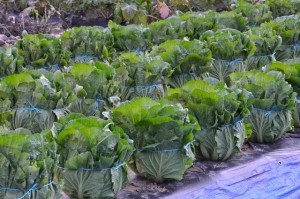
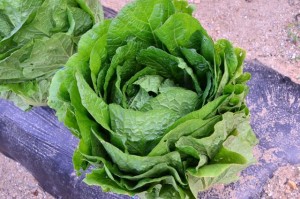
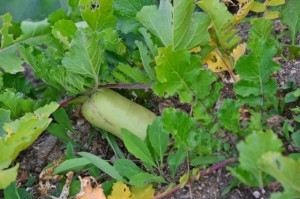
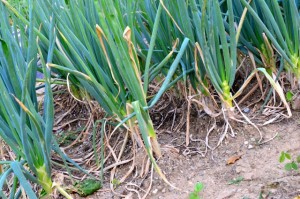

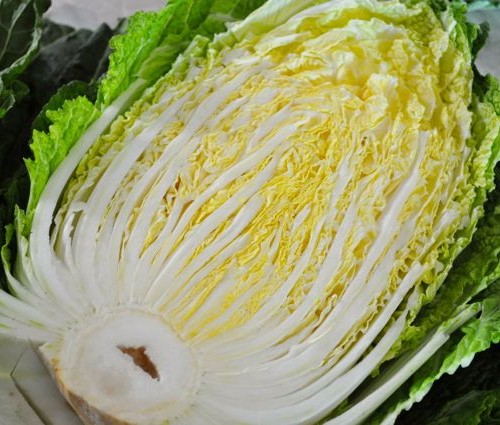


















Hi Jinjoo, I’m trying to make kimchi right now and I’ve just finished brining the cabbage. Is it normal for the cabbage to taste salty? It’s like more than normal salty. Or I’ve ruined my cabbage?
Hi Anis, yes, if you tried to taste the freshly brined cabbage (esp. before rinsing), it’s going to taste really salty – unpleasantly salty. But once you make the kimchi seasoning and let it ripen, it should balance out. Are you following my brining recipe? Good luck!
Yes i am jinjoo! Thank you so mucb for sharing your recipe!
Hi, thank you for this post:)
May I please ask how exactly it is with the brine? Would it be alright to use 2tbsp per liter for the brine or is it too much? Also, is pink Himalayan salt recommended as well?
Thank you very much
Thank you – my suggestion is to follower this recipe – https://kimchimari.com/easy-kimchi-cabbage-recipe-blender/ I have the latest details there. Use the brine recipe in that post. I do not recommend Himalayan salt for kimchi. Korean sea salt is best or other sea salts are better. You can read more about salt and kimchi here – https://kimchimari.com/best-salt-kimchi-12-salts/
Thank you very much for your recipe. I wanted to make the kimchi paste but then I realized that I don’t have any garlics. It’s late and I have to buy garlic tomorrow. I was wondering, does it matter if I leave the cabbage sit in brine for more than 24 hours? Won’t they be damaged? Or it’s better to rinse them and put them in the fridge?
Oh dear – sorry for the late response. I have been having trouble with comment notification lately.. so it’s probably too late but it’s better to take out the cabbage, drain, rinse and then you could keep them in the fridge for 1-2 days. Hopefully things worked out.
Hi! Thank you for this! But i have a question, after brining and rinsing the cabbage, can i put it inside the refrigerator and put the paste the next day? I’ve been doing kimchi mostly at midnight and it’s keeping me up all night. So i was wondering if this is possible and if it will affect the crunchiness of the kimchi? thank you!
You can store it in the refrigerator overnight and finish the next day without any ill effects. Good luck!
Hi Jinjoo, I really thank you for all your detailed and beneficial posts on kimchi making. Really helped me alot with this process. And I also really really love how you tell us not just recipe but also your experience, tips and memory of the food.
I actually have have some questions still on kimchi that I couldn’t find answer even after much searching. If you would answer them I’d be very grateful.
So I read on some discussions, that too much of headspace in storing kimchi may expose it to oxygen and allow mold growth. Have you had any experience with this? I wanted to use a glass container for my kimchi, but it is quite too big for my kimchi amount, not even fill half of the container actually. Would you think this be fine?
Or alternatively can I put and let the kimchi ferment in a food plastic bag, which I will then store altogether in the container? Would that be a bad idea?
And a last question is can I topup water into the kimchi? My kimchi doesn’t have much juice right now, so it’s not submerged. I read that it is perfectly fine for kimchi not to have much juice, but because of the whole large headspace situation, I thought it would be better if the kimchi is fully submerged. So is it fine if I just a little bit of water?
If you do answer this, I would like to thank you in advance.
Thank you for appreciating my work! It really means a lot to hear it. So.. kimchi being exposed to oxygen without it being covered in juice can sometimes (not always) allow mold to develop or at least the top part may not be as tasty. So you can just cover the top of the kimchi (not jar but kimchi itself) with a plastic wrap so the kimchi is covered and not exposed. Or as you said, you can also store in plastic bag but it will expand or leak so allow air to escape every now and then. Lastly, if it’s been less than a day that you made kimchi, more juice should develop over the next couple days. Within the first 12 hrs you could add a little bit of lightly salted water to the top and press down the kimchi so the juice gets mixed with added salt water. If it’s been a couple days, I would not add salted water, esp not plain water. Should still be fine if you cover it with a plastic wrap. Good luck!